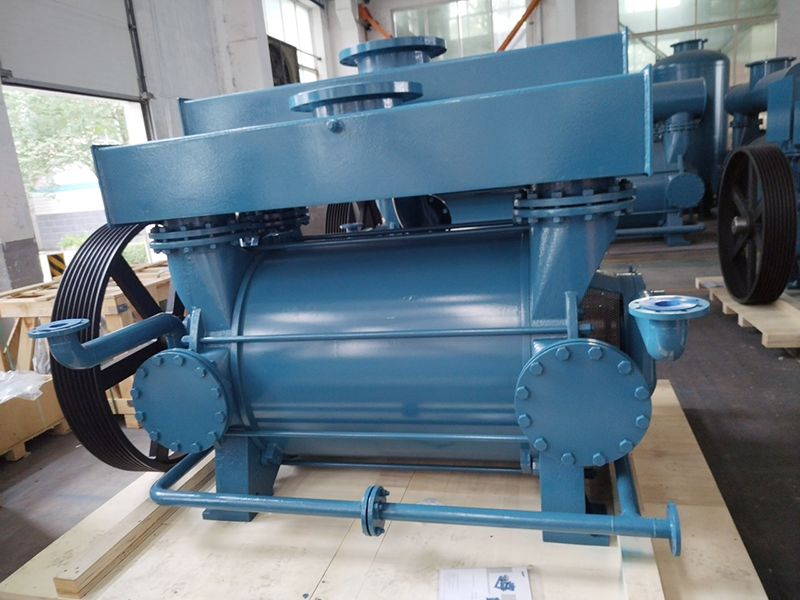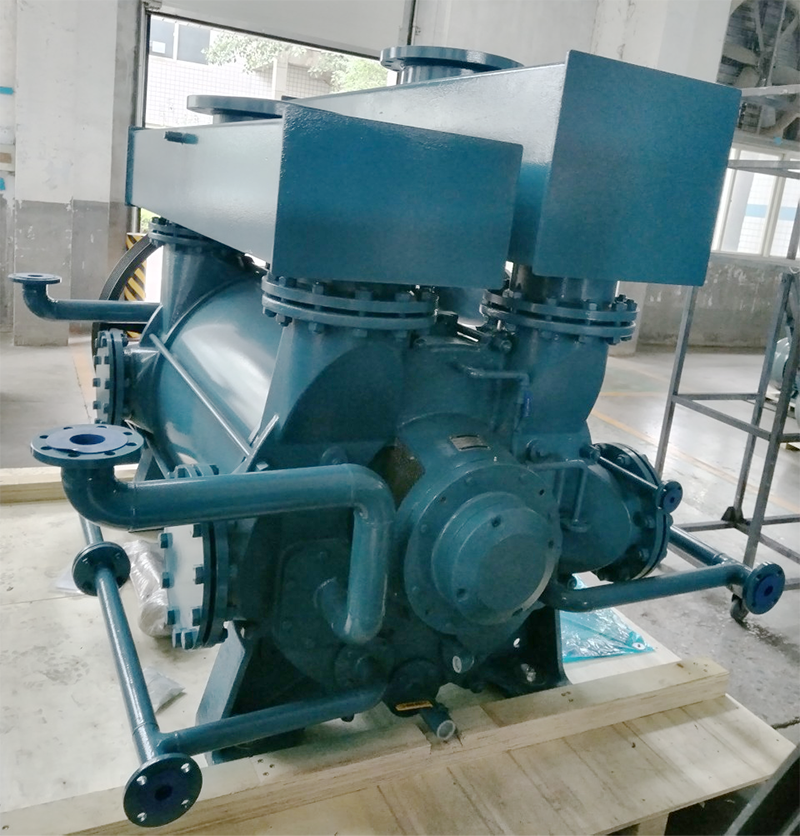Liquid Ring Vacuum Pumps in the Production of MDI
Liquid ring vacuum pumps play a vital role in the production of MDI (methylene diphenyl diisocyanate), but their application differs from the direct removal of by-products in the esterification reaction. In MDI production, the core role of liquid ring vacuum pumps is to provide a safe, stable, and reliable vacuum environment for the phosgenation reaction and subsequent purification steps.
MDI production is primarily divided into three steps:
1.Amine Preparation: Aniline and formaldehyde condense to produce a mixture containing diaminodiphenylmethane (MDA).
2.Phosgenation: This is the most critical application of liquid ring vacuum pumps. MDA reacts with phosgene (COCl₂) to produce MDI.
3.Purification: Crude MDI is purified into various product specifications through methods such as distillation.
The following details the application of liquid ring vacuum pumps in the phosgenation reaction and purification stages.
1.Application in Phosgenation: A Model of Safety and Process Control
Phosgenation is an extremely dangerous process because the raw material, phosgene, is highly toxic. The application of liquid ring vacuum pumps in this process fully demonstrates their unique advantages in handling hazardous and corrosive gases.
1.1. Creating a negative pressure operating environment to ensure absolute safety
- Core requirement: The entire phosgene reaction system must be maintained at a negative pressure (i.e., vacuum). This is the most important safety design feature.
- Role of the liquid ring pump: The liquid ring vacuum pump serves as the ultimate vacuum source for the system, ensuring that even minor leaks in the equipment are caused by external air leaking inward, rather than internal phosgene escaping. This provides the most fundamental guarantee for safe production.
1.2. Removing the byproduct hydrogen chloride (HCl)
- Reaction equation: MDA + COCl₂ → MDI + 2HCl ↑
- The reaction generates a large amount of hydrogen chloride gas. Timely and continuous removal of HCl helps promote the reaction’s forward progress. Liquid ring pumps continuously extract the HCl produced during the reaction and unreacted excess phosgene from the reactor.
1.3. Handling Corrosive Gases and Condensable Vapors
Corrosiveness of Hydrogen Chloride (HCl): HCl gas forms highly corrosive hydrochloric acid when it comes into contact with water. This is a killer for many types of vacuum pumps.
Advantages of Liquid Ring Pumps:
Corrosion Resistance: Liquid ring pumps can be manufactured from corrosion-resistant materials such as Hastelloy and high-grade stainless steel (such as 316L), making them well suited to HCl environments.
Absorption: The working fluid used in liquid ring pumps (usually water or a specific solvent) can partially absorb and dissolve HCl gas within the pump chamber. This acts as a preliminary scrubbing and purification of the exhaust gas while pumping.
Isothermal Compression: The compression process is gentle, avoiding side reactions or equipment damage that could be caused by high temperatures.
2. Application in Purification (Distillation) Processes
MDI purification requires high-vacuum distillation because MDI is heat-sensitive and easily polymerizes or decomposes at high temperatures.
- Boiling Point Reduction: Under high vacuum (typically requiring an absolute pressure of 1 mbar or even lower), the boiling point of MDI can be significantly lowered (from over 300°C at atmospheric pressure to around 200°C). This enables distillation at relatively low temperatures, protecting the heat-sensitive MDI product from decomposition or discoloration.
- The Role of the Liquid Ring Pump: In applications requiring extremely high vacuum, liquid ring vacuum pumps are typically not used as the main pump (because their ultimate vacuum is limited by the saturated vapor pressure of the working fluid, typically to 30 mbar for single-stage pumps and around 10 mbar for two-stage pumps). Instead, they serve as backing pumps (or backpressure pumps).
- Vacuum System Configuration:
- Main Pump (High Vacuum Pump): Typically, a steam ejector or Roots pump is used. These pumps can maintain a high vacuum over a wide flow range, but they cannot exhaust directly to the atmosphere.
- Liquid ring pumps as backing pumps: Their function is to provide a sufficiently low “back pressure” (discharge pressure) for the main pump (such as a Roots pump or a final-stage steam ejector) to enable the main pump to operate normally. They are responsible for compressing the exhaust gas from the main pump to near atmospheric pressure before discharging it.
3.Working Fluid Selection and Exhaust Gas Treatment System
In MDI production, the selection of working fluid and exhaust gas treatment are crucial environmental and safety considerations.
(1). Working Fluid Selection
- Water: The most commonly used. However, this requires high corrosion resistance from the pump, and the resulting hydrochloric acid-containing wastewater requires treatment.
- Concentrated Sulfuric Acid or Alkali: Concentrated sulfuric acid or sodium hydroxide solution is sometimes used as the working fluid. This serves to instantly neutralize and absorb HCl gas within the pump, generating salts (such as NaCl or Na₂CO₃), significantly reducing the burden on the subsequent exhaust gas treatment system. However, this places higher demands on the pump materials and seals.
- Organic Solvents: In certain circumstances, inert organic solvents may be used to avoid the introduction of water.
(2). Exhaust Gas Treatment System
Gases discharged from liquid ring pumps (including uncondensed gases, residual phosgene, HCl, etc.) must never be discharged directly. They enter a complex tail gas destruction system, typically including:
- Multi-stage absorption tower: Uses alkaline solution (such as NaOH) to absorb HCl and phosgene (phosgene decomposes when exposed to alkali).
- High-temperature pyrolysis furnace: Completely decomposes any remaining trace toxic substances at high temperatures.
- Liquid ring pumps effectively serve as the “feed pump” of this tail gas treatment system, safely transporting hazardous gases to the treatment unit.
4.Summary
The application of liquid ring vacuum pumps in MDI production demonstrates their irreplaceable value in chemical processes, particularly those involving hazardous and corrosive media:
4.1. Safety Guardian: Maintaining negative system pressure prevents leakage of highly toxic phosgene, a key component of intrinsically safe design.
4.2. Process Enabler: Removing the reaction byproduct HCl and providing the vacuum required for distillation ensures efficient chemical reactions and product purification.
4.3. Corrosion Resistance: Their simple structure and availability of corrosion-resistant materials make them suitable for handling highly corrosive environments such as HCl. 4. System Core: Serving as a backing pump, it combines with the high-vacuum pump to form a stable and reliable high-vacuum system.
Therefore, liquid ring vacuum pumps are indispensable general-purpose fluid equipment in large, complex, and high-risk chemical plants like MDI.
(The article comes from the Internet. If reprinting is not allowed, please contact our company to delete it.)


